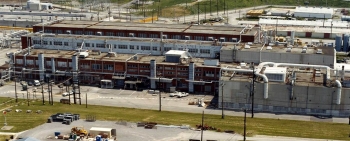
Workers perform repairs on Alpha 4’s four-acre roof at Y-12 National Security Complex. (Photo by DOE/Y-12)
By DOE Office of Environmental Management
The Oak Ridge Office of Environmental Management recently finished repairs to an aging Y-12 National Security Complex building as part of an initiative that is designed to improve safety, reduce cleanup costs, lower risks, and stabilize excess facilities that are contaminated and are expected to be demolished.
Maintaining the roofs of aging, contaminated facilities prevents water damage, the greatest threat to rapid deterioration and the spread of contamination. These factors create a more hazardous environment for future demolition crews that must enter the facility, and they increase the cost of cleanup exponentially.
“We are applying lessons we’ve learned from previous cleanup projects,” said Jay Mullis, acting manager of Oak Ridge Office of Environmental Management, or OREM. “Buildings that are neglected cause cleanup to be much more costly and complicated. Performing smaller tasks like this one to maintain facilities will create considerable savings by the time we begin major demolition at Y-12.”
Workers repaired 20 areas across Alpha 4’s four-acre roof, which has eight decks at various heights. Cleanup contractor URS | CH2M Oak Ridge LLC, or UCOR, worked with Consolidated Nuclear Security, Y-12’s management and operations contractor, and the National Nuclear Security Administration’s Roofing Asset Management Program. The roofing subcontract was awarded to Nations Roofing. The work was completed in three months, two months ahead of schedule and $200,000 under the $1.25 million budget.
Environmental Management has been concerned with water infiltrating the building and intermingling with residual contaminants, particularly mercury in Alpha 4, and becoming mobile. Water has already degraded other facilities. For instance, characterization crews can no longer enter one facility in Y-12’s Biology Complex due to a fallen roof.
Constructed in 1944, the 560,000-square-foot Alpha 4 building activities included enriching uranium using electromagnetic separation as part of the Manhattan Project. The facility was placed in standby as other enrichment methods proved more efficient. In 1953, its original equipment was replaced with column exchange, or COLEX, to support thermonuclear weapons production.
These operations, which required massive amounts of mercury, continued until 1962. Alpha 4 was shut down in 1987.
Note: This story was published by the U.S. Department of Energy Office of Environmental Management on February 14. This story has been lightly edited.
More information will be added as it becomes available.

Alpha 4 at Y-12 National Security Complex supported the nation’s defense missions for years. (Photo by DOE/Y-12)
Do you appreciate this story or our work in general? If so, please consider a monthly subscription to Oak Ridge Today. See our Subscribe page here. Thank you for reading Oak Ridge Today.
Copyright 2016 Oak Ridge Today. All rights reserved. This material may not be published, broadcast, rewritten, or redistributed.
Susan Gawarecki says
Kudos to DOE for doing the right thing.